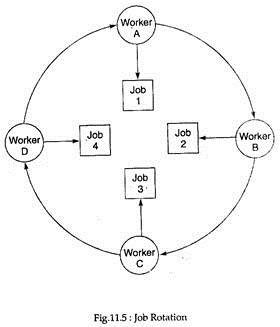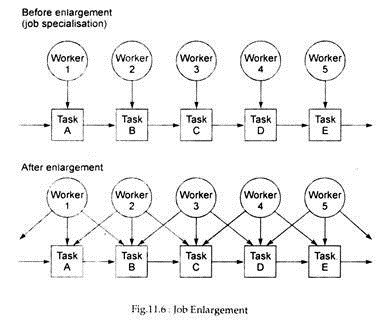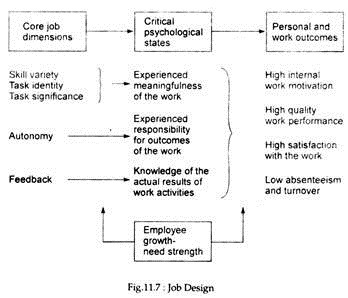This article throws light upon the four main alternatives to work specialisation. The alternatives are: 1. Job Rotation 2. Job Enlargement 3. Job Enrichment 4. Job Design.
Alternative # 1. Job Rotation:
It involves systematically moving employees from one job to another. Fig. 11.5 shows a typical job rotation arrangement. The jobs themselves do not change; rather the worker moves from one job to another. In this context, we may cite the example of an unskilled worker in a typical warehouse.
He might unload trucks on Monday, carry incoming inventory to storage on Tuesday, verify invoices on Wednesday, pull outgoing inventory from storage on Thursday, and load trucks on Friday.
However, the sad truth is that job rotation has not been very successful in enhancing employee motivation or satisfaction. Jobs that are amenable to rotation tend to be relatively standard or routine. A worker who is rotated to a ‘new’ job may show increased interest at first, but sooner or later his interest wanes.
No doubt, many companies such as Ford Motor Company, Western Electric and Bethlehem Steel have tried this technique, but with very little success. All we can say at this stage is that job rotation is most often used today as a training device to improve worker skills and flexibility.
Alternative # 2. Job Enlargement:
Division of labour and specialisation has one major disadvantage. It leads to monetary and boredom. It is felt that if the worker does the same job or performs the same task again and again there is possibility of worker dissatisfaction. Jon enlargement was developed to solve this problem by increasing the number of tasks each worker performs. Fig. 11.6 illustrates the concept.
Before job enlargement, each worker had his own special task. Job enlargement gives each worker more activities to perform in the production process. Consequently, all workers perform a wide variety of tasks and this reduces the level of job dissatisfaction.
Many organisations such as IBM, AT&T, Detroit Edisson have adopted this technique as a means for improving employee motivation. At Maytag, the assembly line for producing washing machines, water pumps was systematically changed.
As a result, the work that had originally been performed by six workers — who passed the work sequentially from one person to another — was performed by four workers, each of whom assembled a complete pump. This led to a rise in labour productivity and consequent cost saving.
No doubt, there are some benefits associated with job enlargement. But, these are offset by several disadvantages: (1) rising training cost, (2) rising demand for wages due to trade union pressure (caused by the fact that the worker is doing more things), and (3) boredom — even after job enlargement because in most cases the work remains routine.
Alternative # 3. Job Enrichment:
A far more comprehensive approach to designing jobs is through job enrichment. Job enrichment is based on Frederich Herzberg’s two-factor theory of motivation. Herzberg argued that because job rotation and job enlargement do not provide the worker with any additional responsibility or control, they do not really enhance employee motivation.
Increasing the range and variety of tasks is not sufficient, by itself, to improve employee motivation. What is needed is a means of providing the worker with actual control over the task. Job enrichment seeks to increase both the number of tasks a worker does and the control the worker has over the job.
To accomplish this, a number of job changes are to be made. Three major changes suggested by Herzberg are:
(1) The manager has to remove some controls from the job,
(2) He has to delegate more authority to employees and
(3) He has to structure the work in complete, natural units.
These changes are supposed to increase the subordinates’ sense of responsibility. Subordinates may also take additional responsibility if the above changes become effective. Herzberg has suggested another change in this context: the manager has to continually assign now and challenging tasks, thereby increasing the employees’ opportunity for growth and advancement.
Various companies such as IBM, Texas Instruments and General Motors have developed job enrichment, but the experience is not quite satisfactory. Various problems have been encountered.
In this context, Griffin comments:
“Analysis of a work system before enrichment is needed but seldom performed, and managers rarely deal with employee preferences when enriching jobs”.
Alternative # 4. Job Design:
Jobs design is an alternative to work specialisation and its takes the work system and employee characteristics more into account. Job design is normally based on the job characteristics theory- developed by Richard Hackman and Greg Oldham, as shown in Fig. 11.7.
Fig.11.7 shows that jobs can be diagnosed and improved along five core dimensions:
i. Skill variety:
The number of things a person does in a job.
ii. Task identity:
The extent to which the worker does a complete or identifiable portion of the total job.
iii. Task significance:
The perceived importance of the task.
iv. Autonomy:
The degree of control the worker has over how the work is performed.
v. Feedback:
The extent to which the worker knows how well the job is being performed.
The Hackman-Oldham model, as presented above, predicts that the higher a job scores on these dimensions, the more employees will experience various desirable psychological states. Experiencing these states is likely to lead to high motivation, high quality performance, high satisfaction and low absenteeism and turnover.
Finally, the overall process is likely to be affected by an individual difference variable called growth-need strength. While people with a strong desire to grow, develop and expand their capabilities are expected to respond as the model predicts, individuals with low growth-need strength are presumed not to respond so strongly or consistently.
Undoubtedly, job design is the most promising contemporary approach to structuring and designing organisational tasks, but it does not seem to be the final answer. In the 21st century, management must still look for new ways to optimise efficiency, productivity, motivation and job satisfaction.


